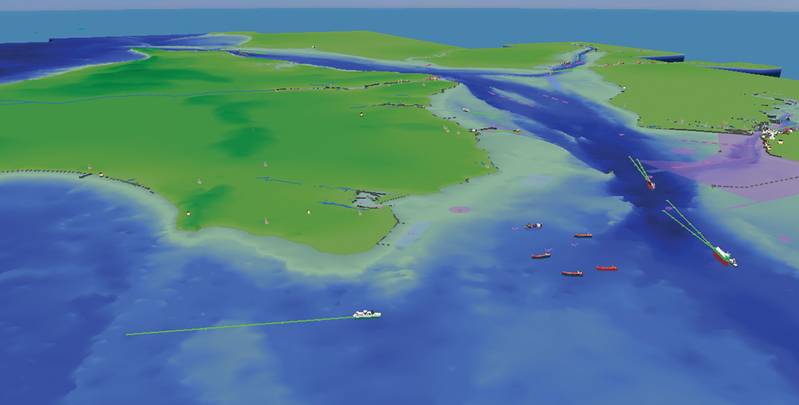3D Vessel Tracking: A New Course in Port Traffic Control
Marine operators and entities have long struggled with the most efficient, effective means to monitor and manage traffic in increasingly busy ports around the world. The marine industry, unlike the airline industry, is unique in that mixed with high levels of commercial traffic is a broad and ever changing mix of personal watercraft of varying sizes, with equal variables in terms of operator experience. Thus the ability to rapidly collect, compute, disseminate and act on information is central to safe port operations. A U.K. company, GeoVS, believes that it has the answer in the form of its new 3D Vessel Tracking System.
“For the past 12 years colleagues and I have been grappling with the complex realities of enhancing situational awareness for maritime safety,” said Dr. Rafal Goralski, Director of Technology at GeoVS. “Only now do technological advances allow the integration of data from many sensors around a port to produce a real time, three dimensional traffic management and visualization tool. This research has resulted in the development of the world’s first commercial three dimensional real time vessel tracking system.”
The System
Managing large ship’s progress, usually in and out of ports and in other restricted channels, has understandably assumed a critical role in ensuring their safety. But the Cardiff based company GeoVS has produced what it is calling the world’s first commercial marine three-dimensional vessel tracking system. This brings a step change in monitoring and management of vessels in ports, estuaries and restricted waterways.
It provides a more comprehensive picture of vessel movements than existing systems, it is easier to use, enhances efficiency and improves safety. “Research in Sweden has shown that the use of three dimensional charts leads to a significant reduction in human error and a similar increase in the operator’s efficiency,” said Dr. Goralski. “The system, which we call , C-Vu 3D VTS works either on its own or as a bolt on to existing two dimensional systems, and can be used by port operators, ships’ pilots and other navigators.”
Vessel Traffic Systems (VTS) are the technology that enable efficient tracking, monitoring, management, recording and analysis of vessel movements in a particular area, such as a port or confined waterway.
Vessel Traffic Systems comprise a set of sensors (most commonly radar, radio based automatic identification systems (AIS) and CCTV, often also tide gauges and meteorological stations), signal processing and storage servers and any number of co-located or distributed VTS operator stations. It presents real-time navigational data overlaid on an electronic chart system (ECS) display.
These systems are used in ports and confined waterways to monitor and control vessels for navigational safety and operational efficiency, and ensure vessels follow designated routes. Users are typically port authorities and Coastguards.
Current Practice
Currently vessel tracking systems largely rely on radar signals and present a 2D picture of vessels moving within the designated area on an electronic chart, displayed on computer screens. They allow port operators or Coastguards to see the vessels and monitor and to control their progress. But they do not identify individual vessels, and the performance of radar systems can be adversely affected by weather. And when vessels are close together, radar blips can merge.
They only show the surface picture, not hazards that lie beneath the water, and thus rely upon the operator’s local knowledge. Neither do they give tidal information, again relying on the operator’s knowledge and experience, which varies from operator to operator.
Despite these limitations, they are still a technological leap forward from the Mark 1 eyeball, and early radar systems which used small and difficult to interpret circular radar screens.
GeoVS’s new system, C-Vu 3D VTS, is a leap forward, according to the company. The picture it presents to operators is more encompassing, clearer and straightforward to understand.
It presents a 3D image and also gives realistic representations of all the vessels, the waterway, port installations and navigational marks such as buoys. At the click of a mouse it shows the underwater picture and hazards vessels may encounter. This includes critical real time tidal data, so the operator knows exactly the depth of water beneath the keel of each vessel. GeoVS’s system draws on information from existing radar systems, and supplements this with inputs from tidal gauges, meteorological stations, and radio based automatic identification systems, which are now mandatory for all commercial vessels. Thus it is designed to present a comprehensive real time picture of what is happening in the waterway, identifying individual vessels, in a way that is straightforward to understand. It improves situational awareness, reduces fatigue, particularly eye strain so enhancing operators efficiency. The system automatically records the picture and can store it for up to 10 years.
Tech Developments
GeoVS’s C-Vu 3D VTS has been made possible by a number of technological advances and a decade’s worth of research and development by Dr. Goralski and colleagues.
The advent of high speed data processing, electronic charts, large LCD screens, improvements to radar, and the introduction of AIS, were essential for enhancements GeoVS’s system brings. “The last two decades have seen unprecedented technological progress in electronics, computers and software,” said Dr Goralski. “With that progress a trend has started to emerge, it is not people who should have to learn how to operate complex technology, and keep bending themselves to its peculiarities and limitations – it is the computer systems which should be optimized to better cater for our needs, enhance our natural capabilities and compensate for our limitations. This will dramatically enhance efficiency and improve the users’ operational comfort.”
In the marine world, as a result of that thinking, the idea for the 3D chart emerged. It was sensible to remove the extra workload and concentration required to interpret two dimensional charts and instead use the natural three dimensional cognitive capabilities of the human brain.”
GeoVS’s states that C-Vu 3D VTS offers a range of benefits, including:
• Reduces operators’ fatigue.
• Built from official electronic charts.
• Hydrographic survey data, and real-time inputs from tide gauges and meteorological instruments.
• A 10-year recording capability for AIS and radar tracks.
• Fully compatible with any existing vessel tracking system..
• Can operate on its own as a fully capable primary vessel tracking display.
www.geovs.com
(As Published in the August 2012 edition of Maritime Reporter - www.marinelink.com)



















